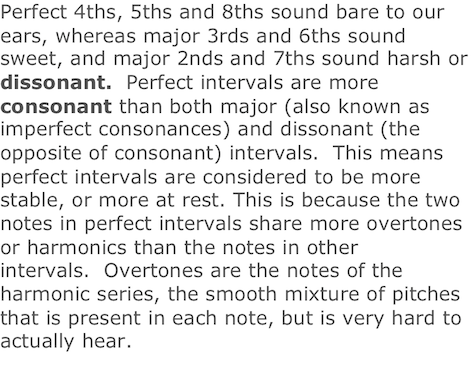Back to andrewdownes.com

Music Education
Resources by Paula Downes, a lot of music by Andrew Downes
Intervals explained!
On this page:
Melodic and Harmonic Intervals
Examples on white notes
Perfect and Major
Minor, Diminished and Augmented
Compound



We will begin by focusing on the white
notes of the keyboard. The notes below all belong to the key and scale of C
major. To work out an interval, you need
to count the first note, the last note and all notes in between.
C to D is a 2nd

C to E is a 3rd

C to F is a 4th

C to G is a 5th

C to A is a 6th

C to B is a 7th

C to C is an 8th or an octave
Now watch the free video below to hear the above examples and also to see them on a keyboard.
Ear Training:
2nd – “Do a Deer”
3rd – “While Shepherds Watched”
4th – “Away in a Manger”
5th – “Lavender’s Blue”
6th – “My Bonny”
7th – “Somewhere over the Rainbow” (first and third notes)
8th – “Somewhere over the Rainbow” (first and second notes)
Watch the free video to hear the tunes:
Return to the top of the page
Major
or Perfect
The examples above are more precisely described as follows:
C to D is a major second (they are 2 semitones/half steps apart)
C to E is a major 3rd
(they are 4 semitones/half steps apart)
C to F is a perfect 4th
(they are 5 semitones/half steps apart)
C to G is a perfect 5th
(they are 7 semitones/half steps apart)
C to A is a major 6th
(they are 9 semitones/half steps apart)
C to B is a major 7th
(they are 11 semitones/half steps apart)
C to C is a perfect octave (they are
12 semitones/half steps apart)
Instead of remembering how many semitones there are, simply
look at the lowest note, work out the major scale starting on that note, and if
the highest note fits into that scale, it will be one of the intervals
above. You just need to remember that the
intervals of a 4th and a 5th are perfect, whereas all the rest are major.
Examples:
D to A
- D major has two sharps, F sharp and C sharp.
- The notes of the scale are: D, E, F sharp, G, A, B, C sharp, D
- A is in the scale of D major.
-
If we count from D to A including
both of those notes, we get
5, so we have a perfect 5th.
A to F sharp
- A major has three sharps, F sharp, C sharp and G sharp.
-
The notes of the scale
are: A, B, C sharp, D, E F sharp, G
sharp, A.
- F sharp is in the scale of A major.
-
If we count from A to F sharp
including both of those notes,
we get 6, so we have a major 6th.
Why
are they called major or perfect?

Perfect intervals are easier to tune, because they don’t sound as ‘perfect’ if they are slightly out, and beating can occur (an unpleasant effect caused by the sound waves going in and out of sync with each other). This is because the ratio of the two pitch frequencies are simple: 2:1 for octaves, 3:2 for 5ths. The strings on violins, violas and cellos are a 5th apart, and on double basses they are a 4th apart, making it easier to tune them. Because the same beating problems don’t occur in 2nds, 3rds, 6ths and 7ths, musicians (not pianists because the pitch is fixed) can make a 2nd, third or a sixth or a 7th wider of narrower depending on taste or on what the harmonies are doing.
Return to the top of the page
Augmented,
Minor and Diminished
* An augmented interval is a semitone/half step wider than a major or a perfect interval.
* A minor interval is a semitone/half step narrower than a major interval.
* A diminished interval is a semitone/half step narrower than a perfect or a minor interval.

C to Db is a minor 2nd
C to D sharp is an augmented 2nd

C to Ebb is a diminished 3rd

C to Eb is a minor 3rd

C to E sharp is an augmented 3rd

C to F flat is a diminished 4th

C to F sharp is an augmented 4th

C to G flat is a diminished 5th

C to G sharp is an augmented 5th

C to Abb is a diminished 6th

C to Ab is a minor 6th

C to A sharp is an augmented 6th

C to Bbb is a diminished 7th

C to Bb is a minor 7th

C to B sharp is an augmented 7th
Now watch the free video below to hear these examples and to see them on a keyboard.
0Save
Ear
training
The first two notes of each tune below will help you to recognize the sound of these intervals.
Minor 2nd - “Young at Heart” – Frank Sinatra
Minor 3rd - "There'll be Bluebirds over the White Cliffs of Dover"
Augmented 4th/Diminished 5th - "Maria", West Side Story or The Simpsons
Augmented 5th/Minor 6th - "Where do I begin", Love Story
Augmented 6th/Minor 7th - "Somewhere", West Side Story
Now listen to them on this free video:
How
to work out whether an interval is Augmented, Minor, or Diminished.
1) Work out the key and notes of the major scale beginning on the lowest note.
2) Change the highest note to the note with that letter name that does belong to this major scale.
3) Count the lowest note, the highest note you worked out in number 2 and all the notes in between.
4) Work out if the actual highest note is a semitone higher or lower than the note you worked out in 2. If it is higher it is augmented, if lower, minor or diminished.
Examples
F to D sharp
1) The key F major contains a Bb. The scale is F, G, A, Bb, C, D, E F, G
2) Change the highest note from D sharp to D because there is no D sharp in F major but there is a D.
3) F –D = 6 notes
4) D sharp is a semitone higher than D, so the interval is augmented. F to D sharp is an augmented 6th.
B to F
1) The key of B major contains F sharp, C sharp, G sharp, D sharp and A sharp. The scale is B, C sharp, D sharp, E, F sharp, G sharp, A sharp, B.
2) Change the highest note from F to F sharp.
3) B – F sharp = 5 notes
4) F is a semitone lower than F sharp, so we have a diminished 5th.
Compound
When an interval is bigger than an octave, we can either call it a 9th,
10th etc, or a compound 2nd, 3rd etc.
For example:
C to Dbb is a Diminished 9th or a Compound Diminished 2nd

C to Db is a Minor 9th or a Compound Minor 2nd

C to D is a Major 9th or a Compound Major 2nd

C to D sharp is an Augmented 9th or a
Compound Augmented 2nd

C to Ebb is a Diminished 10th or a Compound Diminished 3rd

C to Eb is a Minor 10th or a Compound Minor 3rd

C to E is a Major 10th or a Compound Major 3rd

C to E sharp is an Augmented 10th or a
Compound Augmented 3rd

C to Fb is a Diminished 11th or a Compound Diminished 4th

C to F is a Perfect 11th or a Compound Perfect 4th

C to F sharp is an Augmented 11th or a
Compound Augmented 4th

C to Gb is a Diminished 12th or a Compound Diminished 5th

C to G is a Perfect 12th or a Compound Perfect 5th

C to G sharp is an Augmented 12th or a
Compound Augmented 5th

C to Abb is a Diminished 13th or a Compound Diminished 6th

C to Ab is a Minor 13th or a Compound Minor 6th

C to A is a Major 13th or a Compound Major 6th

C to A sharp is an Augmented 13th or a
Compound Augmented 6th

C to Bbb is a Diminished 14th or a Compound Diminished 7th

C to Bb is a Minor 14th or a Compound Minor 7th

C to B is a Major 14th or a Compound Major 7th

C to B sharp is an Augmented 14th or a
Compound Augmented 7th
Now watch the free video to hear them and see them on the keyboard:
Home>Music Theory>Intervals

Music Education
Resources by Paula Downes, a lot of music by Andrew Downes
Back to andrewdownes.com
Follow Cynthia Downes on Instagram to keep up-to-date with her blog posts.
If you have performed in any of Andrew Downes' works or come to listen, please share your experiences in the Premieres Blog! Also see what others have said. Thank you so much for your contribution.





